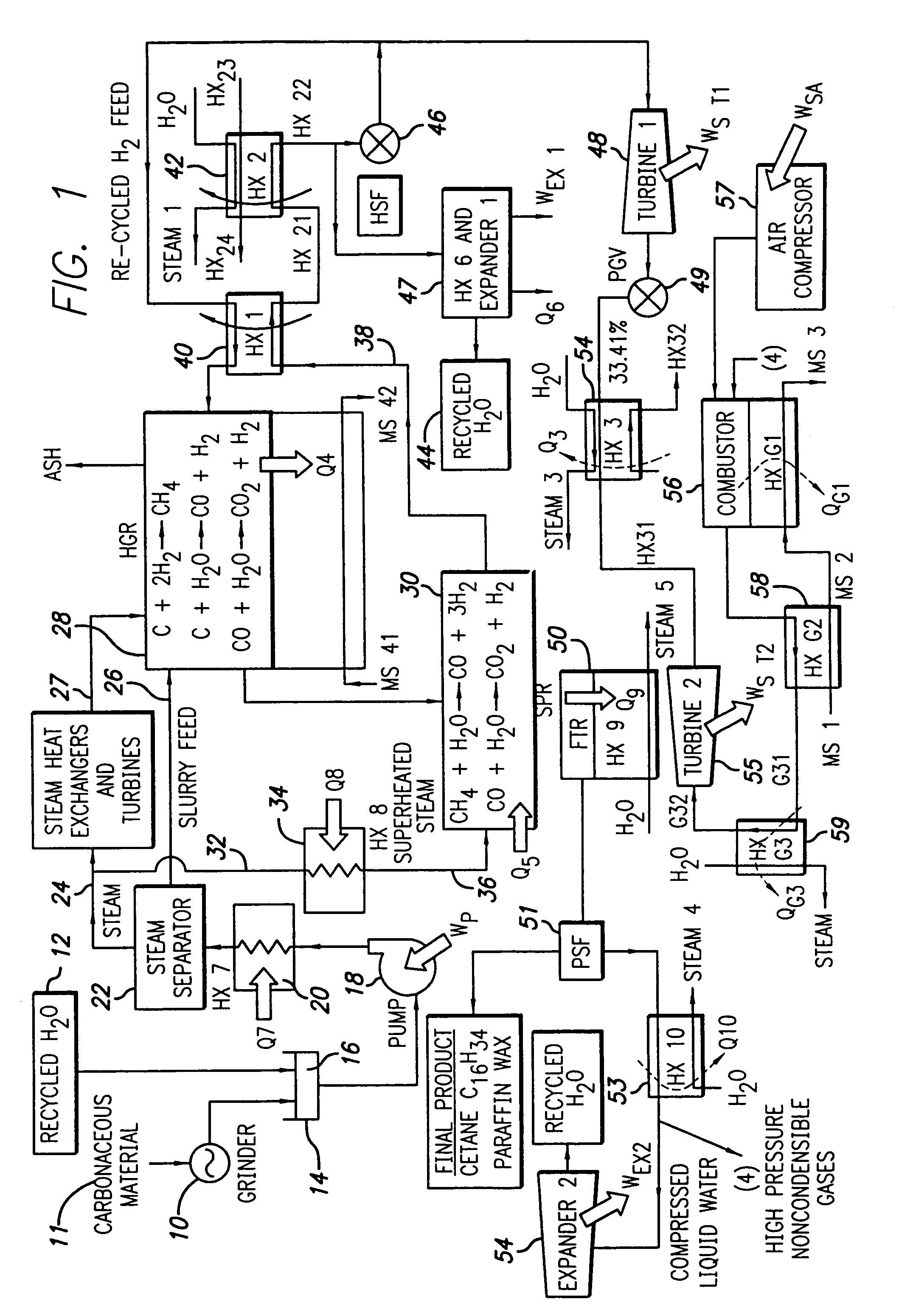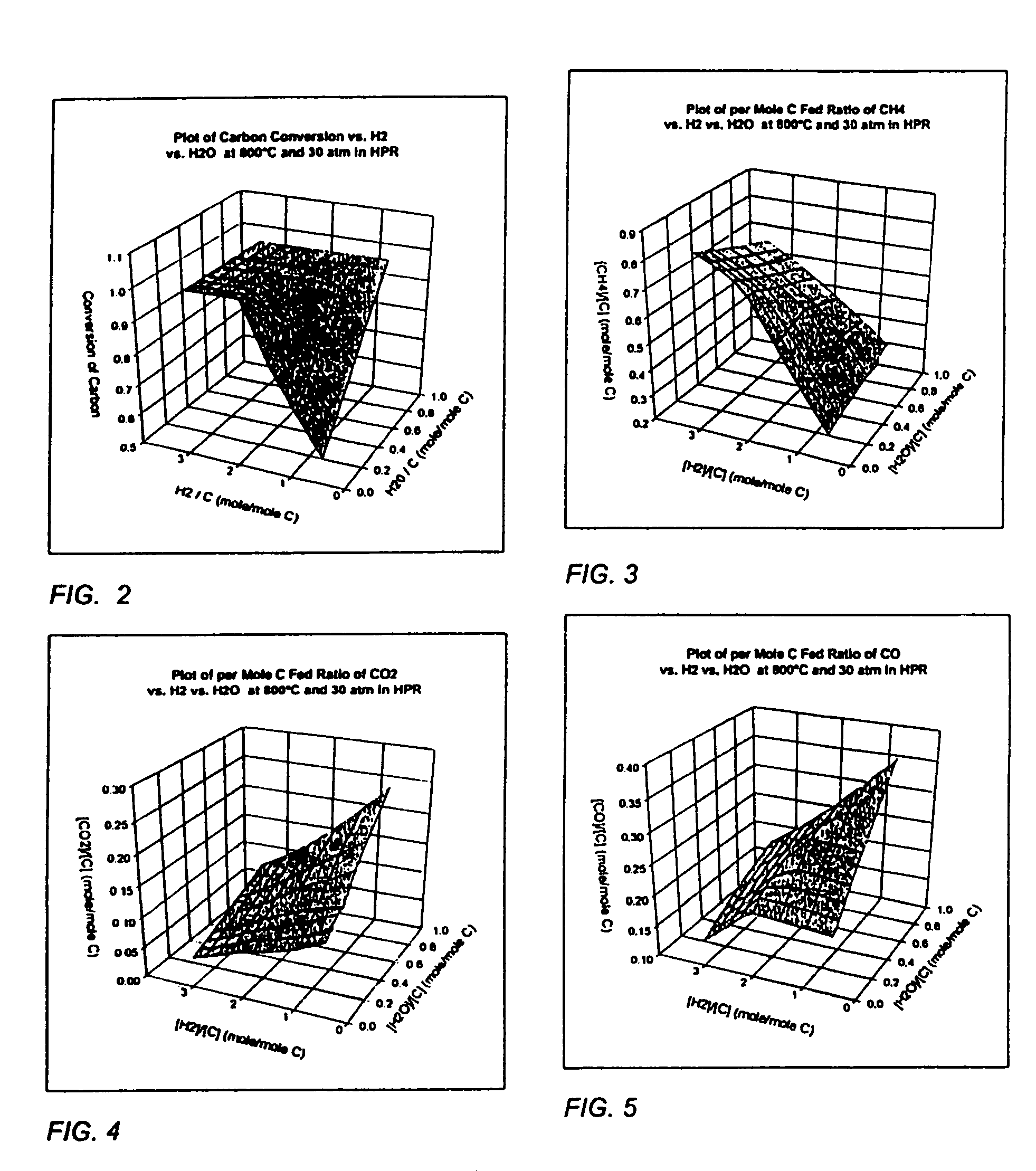Steam pyrolysis as a process to enhance the hydro-gasification of carbonaceous materials
a carbonaceous material and steam pyrolysis technology, applied in the direction of liquid-gas reaction process, gaseous fuel, combustible gas production, etc., can solve the problems of reducing catalyst efficiency, serious environmental pollution, and major dependence on petroleum
- Summary
- Abstract
- Description
- Claims
- Application Information
AI Technical Summary
Benefits of technology
Problems solved by technology
Method used
Image
Examples
example 1
[0123]This example provides a way to carry out steam pyrolysis and hydro-gasification in a micro-batch reactor using real time analysis of gases.
[0124]Pine wood bedding chip material was used as a representative carbonaceous material. Referring to FIG. 39, the pine wood material, water and a gas were added to a reactor vessel 62 and quickly brought to a desired temperature by immersing the vessel in a molten salt bath 64. The vessel was directly coupled to a sample injector 66 and a residual gas analyzer 68 for real-time analysis of the various gas species produced by pyrolysis and hydro-gasification. The partial pressures of the gas species were determined over the course the reaction.
[0125]FIG. 40 provides a typical data record display of the experimental results. Partial pressures values over time are shown for hydrogen 70, methane 72, carbon monoxide 74, and carbon dioxide 76, as well as other gas species.
[0126]In a typical set of experiments, the process combining steam pyrolys...
example 2
[0131]This example provides rate constant measurements for the production of methane gas and carbon monoxide from pine wood material subjected to the four pyrolytic processes.
[0132]Each pyrolytic process was carried out as described in Example 1. Process temperatures were about 580-600° C. (“600° C.”), 670-690° C. (“670° C.”), and 770-790° C. (“770° C.”). The nominal particle size of the pine wood samples was less than about 425 microns (0.425 mm diameter).
[0133]FIG. 41 provides a bar graph showing rate constants in moles per minute for the production of methane gas at different temperatures. At each temperature, the rate constant for steam pyrolysis with helium was greater than the rate constant for either dry pyrolysis process. For example, the rate constant 78 for steam pyrolysis at 670° C. was greater than the rate constant 80 for dry pyrolysis with helium and the rate constant 82 for dry pyrolysis with hydrogen. Further, at both 670° C. and 770° C., the rate constants for the c...
example 3
[0136]This example provides measurements of the total conversion of carbon to carbon containing gases for pine wood material subjected to the four pyrolytic processes.
[0137]Each pyrolytic process was carried out as described in Example 2.
[0138]FIG. 43 is a bar graph showing the % conversion of carbon to carbon containing gases at different temperatures. At each temperature, the % conversion was greater for steam pyrolysis than for either dry pyrolysis process. In addition, at 670° C., and 770° C., the % conversion for steam pyrolysis and hydro-gasification was greater than the % conversion for steam pyrolysis alone.
[0139]These data indicate that steam pyrolysis alone, or combined with hydro-gasification, can enhance the total conversion of carbon to carbon containing gases, and that conversion by steam pyrolysis and hydro-gasification can be greater than by steam pyrolysis alone. Further, the advantages of steam pyrolysis and hydro-gasification can improve with increasing temperatur...
PUM
| Property | Measurement | Unit |
|---|---|---|
| temperature | aaaaa | aaaaa |
| pressure | aaaaa | aaaaa |
| diameter | aaaaa | aaaaa |
Abstract
Description
Claims
Application Information
 Login to View More
Login to View More - R&D
- Intellectual Property
- Life Sciences
- Materials
- Tech Scout
- Unparalleled Data Quality
- Higher Quality Content
- 60% Fewer Hallucinations
Browse by: Latest US Patents, China's latest patents, Technical Efficacy Thesaurus, Application Domain, Technology Topic, Popular Technical Reports.
© 2025 PatSnap. All rights reserved.Legal|Privacy policy|Modern Slavery Act Transparency Statement|Sitemap|About US| Contact US: help@patsnap.com



